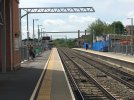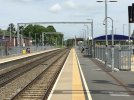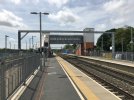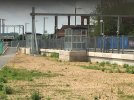-
Our new ticketing site is now live! Using either this or the original site (both powered by TrainSplit) helps support the running of the forum with every ticket purchase! Find out more and ask any questions/give us feedback in this thread!
You are using an out of date browser. It may not display this or other websites correctly.
You should upgrade or use an alternative browser.
You should upgrade or use an alternative browser.
MML Electrification: progress updates
- Thread starter LNW-GW Joint
- Start date
Sponsor Post - registered members do not see these adverts; click here to register, or click here to log in
R
RailUK Forums
More metal work in place at Market Harborough Station today. 3 portals in total over the platforms.
View attachment 114880View attachment 114881View attachment 114882View attachment 114883
It really does utterly destroy the look of a what was a wonderfully rural route doesn’t it?!
Awful.
Flying Phil
Established Member
- Joined
- 18 Apr 2016
- Messages
- 2,036
Thanks for the update PJM that has happened quickly!
PJM
Member
Overnight I think.Thanks for the update PJM that has happened quickly!
Yindee8191
Member
- Joined
- 16 Mar 2019
- Messages
- 175
Everyone’s entitled to their opinion. Personally, I think a route without OHLE looks a bit empty and forlorn. And the wires have their own elegance to them (admittedly more with some designs than others).It really does utterly destroy the look of a what was a wonderfully rural route doesn’t it?!
Awful.
The fact is that beauty is quite irrelevant when it comes to decarbonisation - a world after uncontrolled global warming would be a lot uglier than the one we currently inhabit!
On that basis the lovely rural countryside was utterly destroyed by the building of the railway in the first place!It really does utterly destroy the look of a what was a wonderfully rural route doesn’t it?!
Awful.
I think the utilitarian look of the station redesign is a cause of that too. It's a bit military camp style.It really does utterly destroy the look of a what was a wonderfully rural route doesn’t it?!
Awful.
It really does utterly destroy the look of a what was a wonderfully rural route doesn’t it?!
Awful.
What we see here is much tidier than the elephantine GW sytem, that spoiled TWO Areas of Outstanding Natural Beauty. In particular the MML masts/stanchions do not (except in one case) project above the portal or cantilever. It is this feature (and the random, irregular heights of the masts) that makes the previous system so repulsive and obviously carelessly and wastefully designed. The single clamped portal structure shows how needlessly overweight that system was - leading to even deeper piles! The trussed or latticed beams are better both visually and for strength/weight. The galvanised grey finish is also less obtrusive than red lead.
The station is a bit basic - why not modern platform canopies rather than bus shelters?
Well done NR (eventually).
WAO
Because it's not in London.The station is a bit basic - why not modern platform canopies rather than bus shelters?
Everyone’s entitled to their opinion. Personally, I think a route without OHLE looks a bit empty and forlorn. And the wires have their own elegance to them (admittedly more with some designs than others).
Every railway without OHLE looks empty and folorn? What an extraordinary view (pun intended). Clearly you’re not a fan of the heritage scene, then!

Sadly the modern kit being installed on the MML is some of the worst I’ve seen. I realise that’s to make it durable, but that doesn’t make it any less ugly!
The fact is that beauty is quite irrelevant when it comes to decarbonisation - a world after uncontrolled global warming would be a lot uglier than the one we currently inhabit!
That’s one opinion. Another is that there’s next to nothing we can do in this country while China etc. are still building coal fired power stations, so we might as well accept the inevitable and enjoy the countryside for the next few generations!
On that basis the lovely rural countryside was utterly destroyed by the building of the railway in the first place!
We can’t do anything today to change the fact the railways were built by the Victorians. However we can choose whether or not to make them a great deal uglier!
I think the utilitarian look of the station redesign is a cause of that too. It's a bit military camp style.
Agreed. Thankfully the original station building has been retained (I believe it’s listed), albeit in a fairly sorry state of repair from the looks of things.
What we see here is much tidier than the elephantine GW sytem, that spoiled TWO Areas of Outstanding Natural Beauty. In particular the MML masts/stanchions do not (except in one case) project above the portal or cantilever.
I’m not as familiar with the GWR system but from what I’ve seen it’s also absolutely ghastly.
WesternBiker
Member
I agree with all of that: the GWML designs do seem over-engineered and lumpy.What we see here is much tidier than the elephantine GW system, that spoiled TWO Areas of Outstanding Natural Beauty. In particular the MML masts/stanchions do not (except in one case) project above the portal or cantilever. It is this feature (and the random, irregular heights of the masts) that makes the previous system so repulsive and obviously carelessly and wastefully designed. The single clamped portal structure shows how needlessly overweight that system was - leading to even deeper piles! The trussed or latticed beams are better both visually and for strength/weight. The galvanised grey finish is also less obtrusive than red lead.
Technical question for those who know these things:
Do these structures allow for the same wire tensioning as the heavier GWML structures (which I recall was part of the justification)?
If so, why did we end up with such over-engineering on the GWML? If not, why the difference on the MML?
Many thanks!
Or more realistically, it doesn't have the traffic that even most of the quietest smallest London stations do i.e courses for horses.Because it's not in London.
The GWR OLE is run at 125mph now and I believe that the possibility of 140mph (which would require a higher tension, especially for multiple pantograph operation) has been catered for should the trains have full in-cab signalling. That's called planning for the future.I agree with all of that: the GWML designs do seem over-engineered and lumpy.
Technical question for those who know these things:
Do these structures allow for the same wire tensioning as the heavier GWML structures (which I recall was part of the justification)?
If so, why did we end up with such over-engineering on the GWML? If not, why the difference on the MML?
Many thanks!
Next few generations? The rate of change needs successful decarbonisation to proceed now if we aren't going to make life intolerable for the next generation.That’s one opinion. Another is that there’s next to nothing we can do in this country while China etc. are still building coal fired power stations, so we might as well accept the inevitable and enjoy the countryside for the next few generations!
Last edited:
Verulamius
Member
- Joined
- 30 Jul 2014
- Messages
- 289
In 19/20 total usage for Market Harborough was around 900k.
This is similar to usage for Carshalton Beeches.
This is similar to usage for Carshalton Beeches.
I agree with the OP, modern railways look unfinished without electrification.Every railway without OHLE looks empty and folorn? What an extraordinary view (pun intended). Clearly you’re not a fan of the heritage scene, then!
59CosG95
Established Member
ISTR that the Series 1 OLE on the GWML is tensioned at 13kN/16.5kN (catenary and contact respectively); certainly, that's what its maximum tension is on the design drawings, and I believe that's what it's been installed at as well.The GWR OLE is run at 125mph now and I believe that the possibility of 140mph (which would require a higher tension, especially for multiple pantograph operation) has been catered for should the trains have full in-cab signalling. That's called planning for the future.
The heavy S1 structures have been used for operational resilience more than anything else (and not just because the boom could probably survive the weight of something like 50 elephants being dropped on it); in 4-track areas (e.g. Reading - Didcot, Bedford - Kettering etc.), the need to thread out-of-running tail wires around all the other tracks (as is the case on Mk3 OLE) is negated. It also vastly reduces pantograph hookover risk where contact wires cross, as the wires don't cross at all! They just move up and down in the vertical plane whilst being parallel to each other.
That's good to know. We've had years of cheap flimsy headspans that not onnly make all tracks' OLE mechanically live, but also inevitably cause extensive damage from a single hookover or even broken droppers. The ECML and much of the original MML have endured headspans for decades and must have cost more in disruptio, rework and customer relations than was saved over sensible OLE. Unless it was done because sombody wanted pretty wires rather than reliable ones.ISTR that the Series 1 OLE on the GWML is tensioned at 13kN/16.5kN (catenary and contact respectively); certainly, that's what its maximum tension is on the design drawings, and I believe that's what it's been installed at as well.
The heavy S1 structures have been used for operational resilience more than anything else (and not just because the boom could probably survive the weight of something like 50 elephants being dropped on it); in 4-track areas (e.g. Reading - Didcot, Bedford - Kettering etc.), the need to thread out-of-running tail wires around all the other tracks (as is the case on Mk3 OLE) is negated. It also vastly reduces pantograph hookover risk where contact wires cross, as the wires don't cross at all! They just move up and down in the vertical plane whilst being parallel to each other.
Presumably S1 is using Tensorex units or equivalent?
59CosG95
Established Member
I don't think aesthetics were the driving force behind headspans; their quick installation and pre-fabrication before delivery to site helped their cause a lot. Cost of installation was a big drive at the time Mk3 equipment came into being at the start of the 70s - bespoke portals went out the window, and the amount of copper was reduced as far as practicable.That's good to know. We've had years of cheap flimsy headspans that not onnly make all tracks' OLE mechanically live, but also inevitably cause extensive damage from a single hookover or even broken droppers. The ECML and much of the original MML have endured headspans for decades and must have cost more in disruptio, rework and customer relations than was saved over sensible OLE. Unless it was done because sombody wanted pretty wires rather than reliable ones.
Presumably S1 is using Tensorex units or equivalent?
But yes - the cost of disruptions, rework and customer relations (both financial and societal) has probably outweighed the savings at the time.
Also, at least with the 4-track headspans, they stick upwards much higher than the S1 portals!
S1 (and its successor, UKMS 140) exclusively uses Tensorex; AFAIK the only BWAs left on the GWML are concentrated in London, and even then most are now anti-fall ones.
And which, I believe, has canopiesIn 19/20 total usage for Market Harborough was around 900k.
This is similar to usage for Carshalton Beeches.
DannyMich2018
Member
- Joined
- 19 Dec 2018
- Messages
- 827
Talking about Market Harborough Station why does NR waste money on having the platform lights switched on during daylight hours on the northbound platform? In this day of high energy prices seems such a waste.And which, I believe, has canopies
I agree with the OP, modern railways look unfinished without electrification.
I maintain that this is an extremely bizarre, niche view of the kind I would only ever expect to encounter on here. I use railways everyday which have not been electrified since they were built in Victorian times, or were electrified with (much more aesthetically pleasing) third rail in the 1920s. They do not look in anyway “unfinished” and it is odd to suggest otherwise!
Last edited:
Elecman
Established Member
You should ask EMR as they are the station operator not Network Rail.Talking about Market Harborough Station why does NR waste money on having the platform lights switched on during daylight hours on the northbound platform? In this day of high energy prices seems such a waste.
To be fair, at the moment it looks unfinished because there's only the supporting gantries/cantilevers in place, and no OLE itself! I think that may have been the point the original comment was getting at. I agree that, in general, Railways do not need OLE infrastructure to look 'finished'.I maintain that this is an extremely bizarre, niche view of the kind I would only ever expect to encounter on here. I use railways everyday which have not been electrified since they were built in Victorian times, or were electrified with (much more aesthetically pleasing) third rail in the 1920s. They do not look in anyway “unfinished” and it is odd to suggest otherwise!
WesternBiker
Member
It does indeed: but I don't think there's necessarily much correlation between passenger numbers and canopies: some quiet rural station have managed to retain them, while others in more urban areas lost them in the rationalisations of the 1960s and 1970s.And which, I believe, has canopies
If I recall correctly, there have been no canopies on the platforms at Market Harborough since the 1960s rebuilding either, so the latest rebuilding (to reduce the curvature and improve the line speed through the station) has simply maintained that status quo - though I share the sentiment that reinstating canopies would have been an improvement. At least Market Harborough's handsome main entrance building (which is listed) has been retained.
Surely it depends entirely what you are used to seeing at your local station? If you are used to electrification and use electric trains daily then it does seem a bit odd without itI maintain that this is an extremely bizarre, niche view of the kind I would only ever expect to encounter on here. I use railways everyday which have not been electrified since they were built in Victorian times, or were electrified with (much more aesthetically pleasing) third rail in the 1920s. They do not look in anyway “unfinished” and it is odd to suggest otherwise!
To say a railway looks 'unfinished' without electrification is quite an extreme viewpoint, even if somebody has only ever used electrified track.Surely it depends entirely what you are used to seeing at your local station? If you are used to electrification and use electric trains daily then it does seem a bit odd without it
However the comment that started this branch of the discussion could be interpreted to be referring only to the recently installed Gantries/TTCs, which without the Registration Arms, SPS and Cabling does indeed look a bit bare and unfinished (because it is!)
So? That's my opinion, which is just as valid as anyone else's... modern railways are electrified, they just are/should beTo say a railway looks 'unfinished' without electrification is quite an extreme viewpoint, even if somebody has only ever used electrified track.
GRALISTAIR
Established Member
Amen to that.So? That's my opinion, which is just as valid as anyone else's... modern railways are electrified, they just are/should be
I didn't say it was an invalid opinion, just that my opinion was that it was extreme. My opinion is that modern railways don't need electrification everywhere, and that's as valid as yours is.So? That's my opinion, which is just as valid as anyone else's... modern railways are electrified, they just are/should be
alf
On Moderation
Has Market Harborough’s useful pedestrian tunnel from the main entrance to the up platform been retained, or have we got to make a dogleg walk & climb via the new footbridge?If I recall correctly, there have been no canopies on the platforms at Market Harborough since the 1960s rebuilding either, so the latest rebuilding (to reduce the curvature and improve the line speed through the station) has simply maintained that status quo - though I share the sentiment that reinstating canopies would have been an improvement. At least Market Harborough's handsome main entrance building (which is listed) has been retained.
Nicholas Lewis
On Moderation
There not bothered DfT just pay their bills.You should ask EMR as they are the station operator not Network Rail.




